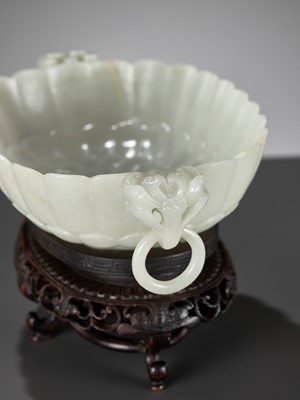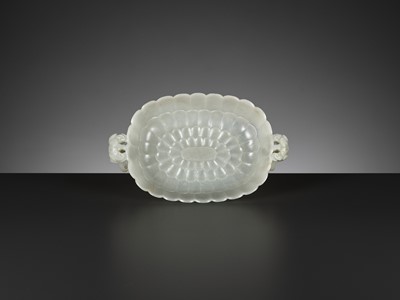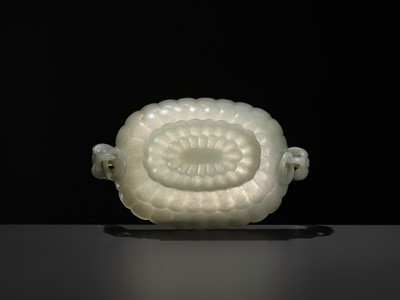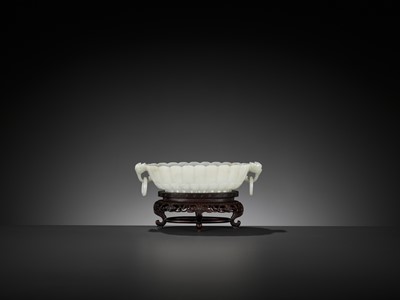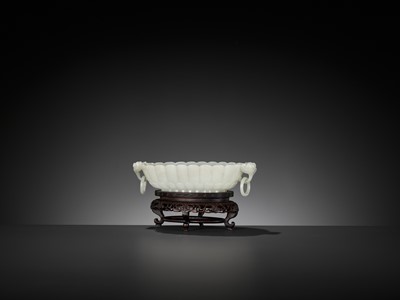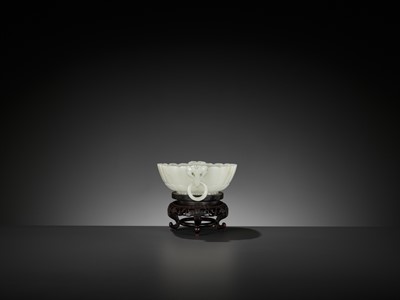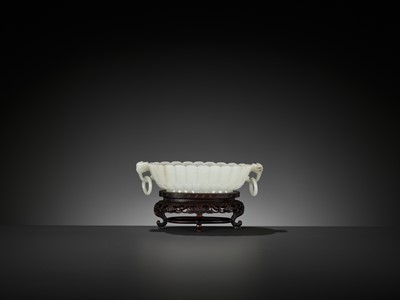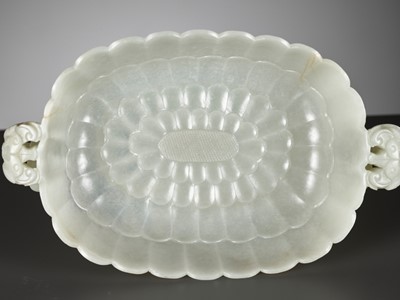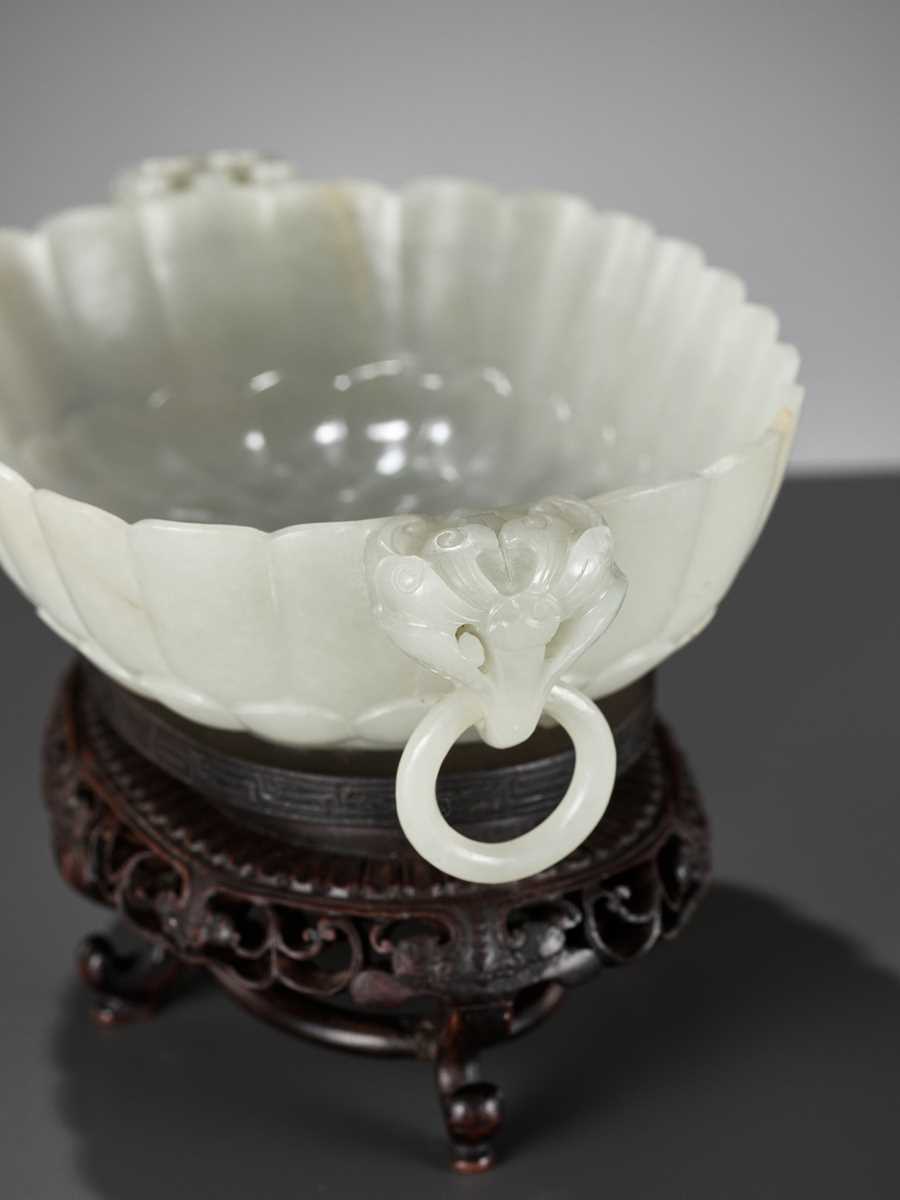9th Mar, 2023 13:00
TWO-DAY AUCTION - Fine Chinese Art / 中國藝術集珍 / Buddhism & Hinduism
46
A MUGHAL-STYLE WHITE JADE ‘CHRYSANTHEMUM’ MARRIAGE BOWL, 18TH CENTURY
十八世紀蒙兀兒風格菊花雙耳活環白玉洗
Sold for €6,500
including Buyer's Premium
China. Superbly carved as a chrysanthemum flowerhead, the elegantly-rounded sides with finely-curved petals radiating from the central pistil, the foot similarly carved as petals, flanked by bat-form handles suspending loose rings, the translucent stone of a pure white tone with russet veins.
Provenance: From a noted private collection of jades and snuff bottles.
Condition: Very good condition with minor wear, microscopic nicks, the stone with natural inclusions and fissures, some of which have developed into small hairline cracks over time.
Weight: 203.9 g (excl. stand)
Dimensions: Length 17.8 cm (across)
With a finely carved and fitted zitan stand dating from the same period. (2)
The present lot demonstrates the craftsmanship achieved in the jade ateliers during the height of the Qing dynasty. 'Hindustani' jades, as they were called by the Qianlong Emperor, were highly prized and therefore influenced Chinese jade carvings. Bowls decorated with auspicious symbols expressing wishes relating to marital bliss and blessing were traditional gifts bestowed at Imperial celebrations.
Chrysanthemums were emblematic of longevity and fertility, because of their health-giving properties and the multitude of their petals. The word for chrysanthemum is a homophone with that for 'eternity' but also with the number nine which also evoked infinity, being the product of three times three, the most basic unit comprising Heaven, Man and Earth.
From at least the Han dynasty, people drank chrysanthemum wine on the ninth day of the ninth lunar month to prolong their life. As symbols of good luck and happiness, bats have few rivals in Chinese culture, and their admiration for bats is ancient. The Chinese word for bat is 'fu,' pronounced the same as the word for good fortune.
Out of over 800 compositions which the Emperor wrote on jade, more than 50 were devoted to Mughal jade, which he described as 'thin as paper'. One such example is a poem written in 1770 in praise of a Hindustan white jade bowl and may be translated as:
Hindustan jade is selected from the river,
Smoothed by stream water to give its exceptional finish.
Fine workmanship makes a myriad of petals to form a steady foot,
Double flowers are exquisitely paired.
Fine jade comes from Xi Cheng* as of old,
Fair and delicate it now surpasses the jade maiden.
Forbidden to be used regardless of the tea,
A stern prohibition edict issued long hence.
*Name of an ancient location near Xinjiang
This poem was also followed by a note written by the Emperor, in which he mentions that the Hindustan bowl is carved with “twelve long leaves rising to the mouth rim, flanked by a pair of handles each in the form of a flower supported on leaves. The material is glossy and smooth, worked to be thin as paper. This fine jade is so exquisitely carved that it is unable to be reproduced by craftsmen of the Middle Kingdom”.
Auction result comparison:
Type: Closely related
Auction: Christie’s Hong Kong, 28 November 2012, lot 2357
Price: HKD 437,500 or approx. EUR 67,500 converted and adjusted for inflation at the time of writing
Description: A Mughal pale celadon jade chrysanthemum dish, 18th century
Expert remark: Note the similar size (18.9 cm).
十八世紀蒙兀兒風格菊花雙耳活環白玉洗
中國。玉洗精雕細琢,側邊圓潤,器壁琢成多層次菊瓣形狀,中央為花蕊,全器光素無紋。兩側蝙蝠形耳懸活環,玉料純白半透明,帶赤褐色紋理。
來源:知名玉器和鼻烟壺私人收藏。
品相:狀況極好,有輕微磨損、刻痕,帶有天然內含物和裂紋,其中一些隨著時間的推移已經發展成細小的裂紋。
重量:203.9 克 (不含底座)
尺寸:長17.8 厘米 (兩耳之間)
紫檀雕刻底座,來自同一時期。 (2)
本拍品展示了清朝鼎盛時期精湛的玉器雕刻工藝。乾隆皇帝稱其為痕都斯坦玉器,非常珍貴,很大程度上影響了中國玉雕技術。此類裝飾有吉祥紋飾的玉洗,表達與婚姻幸福的願望,是皇家慶祝活動中贈送的傳統禮物。從漢代開始,古人就喜歡在農曆九月初九喝菊花酒以延年益壽。而蝙蝠的“蝠”與“福”發音相同,是吉祥幸福的象徵。
痕都斯坦玉器通體玲瓏薄透,拿在手上又輕又巧,有輕若浮雲之感。正如乾隆皇帝稱讚的那樣:“在手疑無物,定睛知有形。”“薄於紙更輕於銖”、“撫外影瞻內”。這種追求玉器薄胎、透明的工藝是痕都斯坦玉器的一大特色。
拍賣結果比較:
形制:非常相近
拍賣:香港佳士得,2012年11月28日,lot 2357
價格:HKD 437,500(相當於今日EUR 67,500)
描述:十八世紀痕都斯坦青白玉菊瓣盤
專家評論:請注意相似的尺寸(18.9 厘米)。
China. Superbly carved as a chrysanthemum flowerhead, the elegantly-rounded sides with finely-curved petals radiating from the central pistil, the foot similarly carved as petals, flanked by bat-form handles suspending loose rings, the translucent stone of a pure white tone with russet veins.
Provenance: From a noted private collection of jades and snuff bottles.
Condition: Very good condition with minor wear, microscopic nicks, the stone with natural inclusions and fissures, some of which have developed into small hairline cracks over time.
Weight: 203.9 g (excl. stand)
Dimensions: Length 17.8 cm (across)
With a finely carved and fitted zitan stand dating from the same period. (2)
The present lot demonstrates the craftsmanship achieved in the jade ateliers during the height of the Qing dynasty. 'Hindustani' jades, as they were called by the Qianlong Emperor, were highly prized and therefore influenced Chinese jade carvings. Bowls decorated with auspicious symbols expressing wishes relating to marital bliss and blessing were traditional gifts bestowed at Imperial celebrations.
Chrysanthemums were emblematic of longevity and fertility, because of their health-giving properties and the multitude of their petals. The word for chrysanthemum is a homophone with that for 'eternity' but also with the number nine which also evoked infinity, being the product of three times three, the most basic unit comprising Heaven, Man and Earth.
From at least the Han dynasty, people drank chrysanthemum wine on the ninth day of the ninth lunar month to prolong their life. As symbols of good luck and happiness, bats have few rivals in Chinese culture, and their admiration for bats is ancient. The Chinese word for bat is 'fu,' pronounced the same as the word for good fortune.
Out of over 800 compositions which the Emperor wrote on jade, more than 50 were devoted to Mughal jade, which he described as 'thin as paper'. One such example is a poem written in 1770 in praise of a Hindustan white jade bowl and may be translated as:
Hindustan jade is selected from the river,
Smoothed by stream water to give its exceptional finish.
Fine workmanship makes a myriad of petals to form a steady foot,
Double flowers are exquisitely paired.
Fine jade comes from Xi Cheng* as of old,
Fair and delicate it now surpasses the jade maiden.
Forbidden to be used regardless of the tea,
A stern prohibition edict issued long hence.
*Name of an ancient location near Xinjiang
This poem was also followed by a note written by the Emperor, in which he mentions that the Hindustan bowl is carved with “twelve long leaves rising to the mouth rim, flanked by a pair of handles each in the form of a flower supported on leaves. The material is glossy and smooth, worked to be thin as paper. This fine jade is so exquisitely carved that it is unable to be reproduced by craftsmen of the Middle Kingdom”.
Auction result comparison:
Type: Closely related
Auction: Christie’s Hong Kong, 28 November 2012, lot 2357
Price: HKD 437,500 or approx. EUR 67,500 converted and adjusted for inflation at the time of writing
Description: A Mughal pale celadon jade chrysanthemum dish, 18th century
Expert remark: Note the similar size (18.9 cm).
十八世紀蒙兀兒風格菊花雙耳活環白玉洗
中國。玉洗精雕細琢,側邊圓潤,器壁琢成多層次菊瓣形狀,中央為花蕊,全器光素無紋。兩側蝙蝠形耳懸活環,玉料純白半透明,帶赤褐色紋理。
來源:知名玉器和鼻烟壺私人收藏。
品相:狀況極好,有輕微磨損、刻痕,帶有天然內含物和裂紋,其中一些隨著時間的推移已經發展成細小的裂紋。
重量:203.9 克 (不含底座)
尺寸:長17.8 厘米 (兩耳之間)
紫檀雕刻底座,來自同一時期。 (2)
本拍品展示了清朝鼎盛時期精湛的玉器雕刻工藝。乾隆皇帝稱其為痕都斯坦玉器,非常珍貴,很大程度上影響了中國玉雕技術。此類裝飾有吉祥紋飾的玉洗,表達與婚姻幸福的願望,是皇家慶祝活動中贈送的傳統禮物。從漢代開始,古人就喜歡在農曆九月初九喝菊花酒以延年益壽。而蝙蝠的“蝠”與“福”發音相同,是吉祥幸福的象徵。
痕都斯坦玉器通體玲瓏薄透,拿在手上又輕又巧,有輕若浮雲之感。正如乾隆皇帝稱讚的那樣:“在手疑無物,定睛知有形。”“薄於紙更輕於銖”、“撫外影瞻內”。這種追求玉器薄胎、透明的工藝是痕都斯坦玉器的一大特色。
拍賣結果比較:
形制:非常相近
拍賣:香港佳士得,2012年11月28日,lot 2357
價格:HKD 437,500(相當於今日EUR 67,500)
描述:十八世紀痕都斯坦青白玉菊瓣盤
專家評論:請注意相似的尺寸(18.9 厘米)。
Zacke Live Online Bidding
Our online bidding platform makes it easier than ever to bid in our auctions! When you bid through our website, you can take advantage of our premium buyer's terms without incurring any additional online bidding surcharges.
To bid live online, you'll need to create an online account. Once your account is created and your identity is verified, you can register to bid in an auction up to 12 hours before the auction begins.
Intended Spend and Bid Limits
When you register to bid in an online auction, you will need to share your intended maximum spending budget for the auction. We will then review your intended spend and set a bid limit for you. Once you have pre-registered for a live online auction, you can see your intended spend and bid limit by going to 'Account Settings' and clicking on 'Live Bidding Registrations'.
Your bid limit will be the maximum amount you can bid during the auction. Your bid limit is for the hammer price and is not affected by the buyer’s premium and VAT. For example, if you have a bid limit of €1,000 and place two winning bids for €300 and €200, then you will only be able to bid €500 for the rest of the auction. If you try to place a bid that is higher than €500, you will not be able to do so.
Online Absentee and Telephone Bids
You can now leave absentee and telephone bids on our website!
Absentee Bidding
Once you've created an account and your identity is verified, you can leave your absentee bid directly on the lot page. We will contact you when your bids have been confirmed.
Telephone Bidding
Once you've created an account and your identity is verified, you can leave telephone bids online. We will contact you when your bids have been confirmed.
Classic Absentee and Telephone Bidding Form
You can still submit absentee and telephone bids by email or fax if you prefer. Simply fill out the Absentee Bidding/Telephone bidding form and return it to us by email at office@zacke.at or by fax at +43 (1) 532 04 52 20. You can download the PDF from our Upcoming Auctions page.
How-To Guides
How to Create Your Personal Zacke Account
How to Register to Bid on Zacke Live
How to Leave Absentee Bids Online
How to Leave Telephone Bids Online
中文版本的操作指南
创建新账号
注册Zacke Live在线直播竞拍(免平台费)
缺席投标和电话投标
Third-Party Bidding
We partner with best-in-class third-party partners to make it easy for you to bid online in the channel of your choice. Please note that if you bid with one of our third-party online partners, then there will be a live bidding surcharge on top of your final purchase price. You can find all of our fees here. Here's a full list of our third-party partners:
- 51 Bid Live
- EpaiLive
- ArtFoxLive
- Invaluable
- LiveAuctioneers
- the-saleroom
- lot-tissimo
- Drouot
Please note that we place different auctions on different platforms. For example, in general, we only place Chinese art auctions on 51 Bid Live.
Bidding in Person
You must register to bid in person and will be assigned a paddle at the auction. Please contact us at office@zacke.at or +43 (1) 532 04 52 for the latest local health and safety guidelines.
